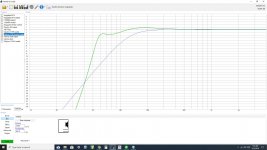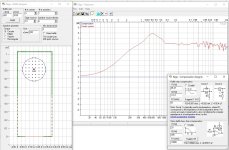The point is that you will not need full baffle step since there will be lots of boundary reinforcement. That means that you can get by with a woofer that doesn't have to be 4-6dB more sensitive than midrange.
You mean down firing is easier?
I think a big impact on price of passive will be whether the mid has to be high-passed, or can get away without high-pass bc it would be mounted in a small sealed space. If it needed to be high-passed, we're talking about a very expensive set of caps at the least, plus another set of big inductors.
Here it is.
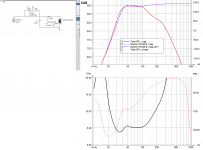
ERSE - Super Q
ERSE - IXQ Coil
330uF 100V Electrolytic Non-Polarized Crossover Capacitor
200uF 100V Electrolytic Non-Polarized Crossover Capacitor
50uF 100V Electrolytic Non-Polarized Crossover Capacitor
https://www.parts-express.com/dayton-audio-dnr-70-7-ohm-10w-precision-audio-grade-resistor--004-7
https://www.parts-express.com/22-ohm-10w-resistor-wire-wound-5-tolerance--016-22
R1 is 3 x 22 ohm resistors in parallel, C2 is 330uF+50uF.
Crossover point would be around 150Hz. It's 6dB/o slope at crossover frequency and after 300Hz there is a steeper slope for less interaction with midrange - elliptical filter. 6dB/o acoustical slope at crossover frequency so there shouldn't be any bad interaction or dip forming due to low phase shift. Erse coils are quite amazing actually so no harm in using them.
https://www.youtube.com/watch?v=sxJBK4JIYJk
I'd definitely mount the woofer bellow the Tannoy DC on the front baffle - but that's just me. Simulation is given for Dayton Audio PA380-8 in a 100 liter cabinet with tuning frequency at 40Hz.Purple line is without crossover and bordeaux is with crossover in place.

ERSE - Super Q
ERSE - IXQ Coil
330uF 100V Electrolytic Non-Polarized Crossover Capacitor
200uF 100V Electrolytic Non-Polarized Crossover Capacitor
50uF 100V Electrolytic Non-Polarized Crossover Capacitor
https://www.parts-express.com/dayton-audio-dnr-70-7-ohm-10w-precision-audio-grade-resistor--004-7
https://www.parts-express.com/22-ohm-10w-resistor-wire-wound-5-tolerance--016-22
R1 is 3 x 22 ohm resistors in parallel, C2 is 330uF+50uF.
Crossover point would be around 150Hz. It's 6dB/o slope at crossover frequency and after 300Hz there is a steeper slope for less interaction with midrange - elliptical filter. 6dB/o acoustical slope at crossover frequency so there shouldn't be any bad interaction or dip forming due to low phase shift. Erse coils are quite amazing actually so no harm in using them.
https://www.youtube.com/watch?v=sxJBK4JIYJk
I'd definitely mount the woofer bellow the Tannoy DC on the front baffle - but that's just me. Simulation is given for Dayton Audio PA380-8 in a 100 liter cabinet with tuning frequency at 40Hz.Purple line is without crossover and bordeaux is with crossover in place.
Last edited:
Here it is.
View attachment 791141
ERSE - Super Q
ERSE - IXQ Coil
330uF 100V Electrolytic Non-Polarized Crossover Capacitor
200uF 100V Electrolytic Non-Polarized Crossover Capacitor
50uF 100V Electrolytic Non-Polarized Crossover Capacitor
https://www.parts-express.com/dayton-audio-dnr-70-7-ohm-10w-precision-audio-grade-resistor--004-7
https://www.parts-express.com/22-ohm-10w-resistor-wire-wound-5-tolerance--016-22
R1 is 3 x 22 ohm resistors in parallel, C2 is 330uF+50uF.
Crossover point would be around 150Hz. It's 6dB/o slope at crossover frequency and after 300Hz there is a steeper slope for less interaction with midrange - elliptical filter. 6dB/o acoustical slope at crossover frequency so there shouldn't be any bad interaction or dip forming due to low phase shift. Erse coils are quite amazing actually so no harm in using them.
https://www.youtube.com/watch?v=sxJBK4JIYJk
I'd definitely mount the woofer bellow the Tannoy DC on the front baffle - but that's just me. Simulation is given for Dayton Audio PA380-8 in a 100 liter cabinet with tuning frequency at 40Hz.Purple line is without crossover and bordeaux is with crossover in place.
Wow, thank you for doing that!
Looks like a quite complex crossover, as predicted. The cost of the parts would probably be more than a pair of plate amps...
Planet, why didn't you say so? lol jk
I think my next step is to try and get the Tannoys sounding good on their own, to see if they're worthy of the investment.
The supplied crossover is loud, but all midrange and it doesn't sound balanced at all. For starters, I may try an l-pad on the tweeters to dial them down, but I'm afraid even then they will still be too middy. Maybe they need a higher xo point...
I've got a lot of caps, resistors and coils around to play with.
Will keep updating this thread.
Also, if anyone has any suggestions as to a simple way to shelf the mids in a simple 2 way (both 2nd order) that could point me in the right direction.
Thank you!
Thanx Zvu, that clears up the low pass (2 big chokes & a big cap) + the elliptical bits. What about the High Pass? It is unlikely that a sealed box will provide a roll-off that high. The HP should have a cap instead of the 1st inductor, but the resonance trap wil be similar (ie 2 more big caps and another big choke. And i would not use electolytics. Even cheap poly caps are near beer can size — we did a similar XO (at 250 Hz, ie near an octave higher, helf the parts size), and the parts are big.
I figure the point were active starts to cost less than passive is typically around 200-300 Hz.
dave
I figure the point were active starts to cost less than passive is typically around 200-300 Hz.
dave
I figure the point were active starts to cost less than passive is typically around 200-300 Hz.
dave
I see that now lol
Good rule of thumb.
KnR,
Any updates on this build?
I bit the bullet and ordered a pair of these drivers yesterday, after having heard 4-per-side arrays of Tannoy ceiling drivers at Burning Amp. Naturally, after I placed the order I noticed something in one of your previous posts:
PA speakers for home HiFi use
"The top end rolls off starting at 10k, with its (smooth) 1.34" aluminum dome with bullet phase plug (not tulip)." (emphasis mine)
OK, as far as I can tell that makes this a whole different class of Tannoy DC driver. I only know three tweeter variants: the original pepperpot drivers ($$$ these days), the tulips (which I heard at BA), and the new Omnimagnet design used in the Revolution series and the CMS 803/603/503 ceiling speakers. The Omnimagnet tweeters have a bullet (ogive) phase plug and an annular plastic diaphragm, and use a common magnet structure with the woofer. The CMS 1201 tweeter has an aluminum diaphragm and a Neo magnet that is not shared with the woofer (like a tulip), but according to your observation has an ogive phase plug. Some kind of hybrid or intermediate design? Or have I missed other drivers like this? I wonder if the diaphragm is actually a full dome, or a ring radiator? And whether this is an improvement, or a cost cutting measure? Tannoy do not appear to have published details of this new tweeter arrangement.
I have some suitable test boxes standing by in the garage, and reasonable measurement gear (Omnimic, REW, S&L Woofer Tester II), so I'll work on getting the best set of measurements I can in my small listening room once the drivers arrive. The published FR curve indicates (to my eye at least) that some work may be needed to flatten the response around the xover for hifi use:
https://media63.music-group.com/media/PLM/data/docs/P0C1Y/TANNOY_CMS%201201DC%20P0C1Y_Product%20Information%20Document.pdf
Bill
Any updates on this build?
I bit the bullet and ordered a pair of these drivers yesterday, after having heard 4-per-side arrays of Tannoy ceiling drivers at Burning Amp. Naturally, after I placed the order I noticed something in one of your previous posts:
PA speakers for home HiFi use
"The top end rolls off starting at 10k, with its (smooth) 1.34" aluminum dome with bullet phase plug (not tulip)." (emphasis mine)
OK, as far as I can tell that makes this a whole different class of Tannoy DC driver. I only know three tweeter variants: the original pepperpot drivers ($$$ these days), the tulips (which I heard at BA), and the new Omnimagnet design used in the Revolution series and the CMS 803/603/503 ceiling speakers. The Omnimagnet tweeters have a bullet (ogive) phase plug and an annular plastic diaphragm, and use a common magnet structure with the woofer. The CMS 1201 tweeter has an aluminum diaphragm and a Neo magnet that is not shared with the woofer (like a tulip), but according to your observation has an ogive phase plug. Some kind of hybrid or intermediate design? Or have I missed other drivers like this? I wonder if the diaphragm is actually a full dome, or a ring radiator? And whether this is an improvement, or a cost cutting measure? Tannoy do not appear to have published details of this new tweeter arrangement.
I have some suitable test boxes standing by in the garage, and reasonable measurement gear (Omnimic, REW, S&L Woofer Tester II), so I'll work on getting the best set of measurements I can in my small listening room once the drivers arrive. The published FR curve indicates (to my eye at least) that some work may be needed to flatten the response around the xover for hifi use:
https://media63.music-group.com/media/PLM/data/docs/P0C1Y/TANNOY_CMS%201201DC%20P0C1Y_Product%20Information%20Document.pdf
Bill
KnR,
Any updates on this build?
Bill
Hi Bill,
Yes lots of updates. At first I had them mounted in my test cabs that had holes in it on front and back, so there was little deep bass.
The tweeters seemed to roll off pretty much at 10k, but once I let the speakers play for over a week straight, then listened to them again critically, the tweeters had totally OPENED up and now play as high as they're supposed to.
From what I can tell they're actually 1.34" aluminum domes, not ring radiators, but I could be wrong. I've had them apart when removing the crossover bracket from the woofer basket.
Initially I didn't know the tweeter would come apart on me when removing the tweeter's mounting bolts to remove the large crossover bracket from the woofer basket. It came apart on me and luckily I didn't break anything, I put it back together and centered the tweeter voice coil in its magnet gap as good as I could.
Next phase was properly porting the test cabs. They're 48 liters, I ported them to 53 hz using three 2" ports cut to length, mounted with hot glue on a removable baffle that is screwed on. This really improved the bass response, but it wasn't until I added 6db of baffle step correction that the speakers really came into balance.
No surprise of course. The stock xo doesn't have any bsc because they're ceiling speakers, so the entire ceiling is their baffle.
At this point they sound really awesome, much better than at first, the break in did magic for the tweeters. I also played a 30 hz since wave for 10 hours to break in the woofers, but I have a feeling they've still got a while to go. I only had a mini amp on hand, so I doubt I was feeding the woofers more than 10 watts.
More to come, but so far I'm very happy with how they sound after initial break in and porting to 53 hz plus bsc.
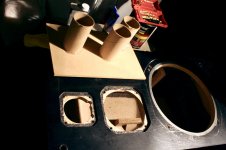
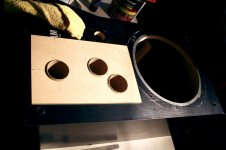
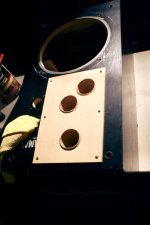
Last edited:
KnR,
Any updates on this build?
Bill
And yes, the phase plug is more like a bullet shape. My previous 8" DCs were tulips, I've also got some pepperpots on hand (SRM12B), and these 1201 DC are definitely not omni magnets.
Cool, thanks for the update. I'm sure that you would know if the diaphragm was a ring radiator, there would have been a hole in the middle. I'll have to get a better look at the phase plug once I get mine.
How did you implement the BSC? Any other crossover tweaks?
Bill
How did you implement the BSC? Any other crossover tweaks?
Bill
Hi Bill,
Yes lots of updates. At first I had them mounted in my test cabs that had holes in it on front and back, so there was little deep bass.
The tweeters seemed to roll off pretty much at 10k, but once I let the speakers play for over a week straight, then listened to them again critically, the tweeters had totally OPENED up and now play as high as they're supposed to.
From what I can tell they're actually 1.34" aluminum domes, not ring radiators, but I could be wrong. I've had them apart when removing the crossover bracket from the woofer basket.
Initially I didn't know the tweeter would come apart on me when removing the tweeter's mounting bolts to remove the large crossover bracket from the woofer basket. It came apart on me and luckily I didn't break anything, I put it back together and centered the tweeter voice coil in its magnet gap as good as I could.
Next phase was properly porting the test cabs. They're 48 liters, I ported them to 53 hz using three 2" ports cut to length, mounted with hot glue on a removable baffle that is screwed on. This really improved the bass response, but it wasn't until I added 6db of baffle step correction that the speakers really came into balance.
No surprise of course. The stock xo doesn't have any bsc because they're ceiling speakers, so the entire ceiling is their baffle.
At this point they sound really awesome, much better than at first, the break in did magic for the tweeters. I also played a 30 hz since wave for 10 hours to break in the woofers, but I have a feeling they've still got a while to go. I only had a mini amp on hand, so I doubt I was feeding the woofers more than 10 watts.
More to come, but so far I'm very happy with how they sound after initial break in and porting to 53 hz plus bsc.
View attachment 795886
View attachment 795887
View attachment 795888
I'm sure that you would know if the diaphragm was a ring radiator, there would have been a hole in the middle.
How did you implement the BSC? Any other crossover tweaks?
Bill
When the tweeter was apart, the phase plug didn't separate from the dome, so I couldn't see the middle of the dome. But the part of the dome I saw definitely looked like a normal dome. I've got some SB Acoustics SB29 dual ring radiators, and their shape looks nothing like what I saw of the Tannoy dome.
About the crossover, I'm not done tweaking yet, just started actually.
Before implementing the BSC, I thought the tweeter needed a good bit of series padding, but before desoldering the entire PCB and rebuilding it point-to-point (to be able to pad the tweeter individually), I thought I'd first try some 'wholesale' BSC to test it out.
What I did was very crude, I simply placed a 2.3 mh inductor with a parallel 5.2 ohm resistor in front of the entire factory crossover for 6db of BSC. Of course that's not ideal, and it did muffle the top end quite a bit, in other words it degraded the top end besides just padding it. That did do wonders for the bass though, so I know I'm onto something.
Now my next step will be to desolder all components from the PCB, to rebuild everything point-to-point to be able to tweak the woofer and tweeter separately. Once I do that, the signal for the tweeter no longer has to travel through all of the woofer's BSC and filter components first.
I was tempted to simply place an l-pad on the tweeter for experimenting, but the ones I've got on hand are 8 ohms, and the tweeters do have that 8.2 ohm parallel resistor built into the factory crossover dropping the tweeter's net resistance to less than 4 ohms.
Last edited:
Finally have some time to mess with this again.
I'm about to desolder all of the xo components from the pcb and arrange everything on cardboard with point-to-point wiring / jumpers, for convenient tweaking.
HUGE FAVOR, if anyone could chime in with some help regarding BSC:
The stock xo has no baffle step compensation, bc they're ceiling speakers. What is the simplest way I can implement BSC?
Do I really have to add a second inductor (with parallel resistor) to the woofer filter, or can I somehow achieve BSC using the woofer's existing 1.75mh inductor?
This is the stock xo schematic:
+ (from amp) > 1.75mh series > 25.0uf parallel > LF
+ (from amp) > 6.8uf series > 0.22mh parallel > 8.2 ohm parallel > HF
I hope that makes sense.
That 1.75mh inductor is very close in value to what the BSC would need, can I use the existing coil to implement BSC by adding a parallel resistor across the 1.75mh inductor?
If not, and I have to add an additional inductor for BSC, do I put it in place before the low-pass filter section?
Thanks for any input.
I've also played the woofer full range, to hear exactly what the low-pass filter does, and it's not radically different, the woofer just plays a little bit higher but there is no audible break up or shoutiness from the woofer full range.
My main problem at this point:
With stock crossover, there's way too much mids. Does the HF 6.8uf + 0.22mh seem like it's accentuating the mids? Wouldn't reducing the capacitor size reduce the output near the xo frequency?
I'm about to desolder all of the xo components from the pcb and arrange everything on cardboard with point-to-point wiring / jumpers, for convenient tweaking.
HUGE FAVOR, if anyone could chime in with some help regarding BSC:
The stock xo has no baffle step compensation, bc they're ceiling speakers. What is the simplest way I can implement BSC?
Do I really have to add a second inductor (with parallel resistor) to the woofer filter, or can I somehow achieve BSC using the woofer's existing 1.75mh inductor?
This is the stock xo schematic:
+ (from amp) > 1.75mh series > 25.0uf parallel > LF
+ (from amp) > 6.8uf series > 0.22mh parallel > 8.2 ohm parallel > HF
I hope that makes sense.
That 1.75mh inductor is very close in value to what the BSC would need, can I use the existing coil to implement BSC by adding a parallel resistor across the 1.75mh inductor?
If not, and I have to add an additional inductor for BSC, do I put it in place before the low-pass filter section?
Thanks for any input.
I've also played the woofer full range, to hear exactly what the low-pass filter does, and it's not radically different, the woofer just plays a little bit higher but there is no audible break up or shoutiness from the woofer full range.
My main problem at this point:
With stock crossover, there's way too much mids. Does the HF 6.8uf + 0.22mh seem like it's accentuating the mids? Wouldn't reducing the capacitor size reduce the output near the xo frequency?
OK I had a chance to desolder one of the crossovers, and play some low level music through the speakers while swapping around components a bit.
I'm using jumper leads with alligator clips to connect stuff point-to-point.
First impression is that the speaker I'm working on seems to play louder and have more bass, so perhaps the crossover on a pcb robs some current / adds restriction?
For starters, I concentrated on the HF high pass, as that is the most glaring issue. So I reconnected the factory low pass as it was with jumper leads.
I briefly tried whether or not a resistor across the woofer's inductor would do anything remotely like BSC, but it didn't to my ears.
On the stock crossovers, the tweeter level seems to be louder than the woofer, so I tried a series resistor before the high pass capacitor, but seemingly that robbed some top end sparkle as well as reduced the level of the HF. Interesting.
I just grabbed a simple 4uf cap as high pass for starters, as the factory 6.8uf plus 0.22mh seems to emphasize the mids way too much.
Lots of playing around to do when I have more time.
A couple tests I'm planning next are:
-Running the high pass filter with the stock components just point-to-point instead, to see if that sounds better.
-Adding series padding to that to see if it is merely out of balance, but fine otherwise.
-Play with smaller caps than 6.8uf, with and without the factory 0.22mh shunt inductor.
-Play with impedance correction on the tweeter
Also I noticed while undoing the components from the stock pcb, that the 8.2 ohm resistor was actually behind the 0.22mh inductor going to ground.
I will say that with one speaker running the stock xo, and the other one running my science experiment with stock low pass point-to-point and a single 4uf cap as high pass, the bass is deeper, the speaker louder, and has more top end sparkle.
I'm using jumper leads with alligator clips to connect stuff point-to-point.
First impression is that the speaker I'm working on seems to play louder and have more bass, so perhaps the crossover on a pcb robs some current / adds restriction?
For starters, I concentrated on the HF high pass, as that is the most glaring issue. So I reconnected the factory low pass as it was with jumper leads.
I briefly tried whether or not a resistor across the woofer's inductor would do anything remotely like BSC, but it didn't to my ears.
On the stock crossovers, the tweeter level seems to be louder than the woofer, so I tried a series resistor before the high pass capacitor, but seemingly that robbed some top end sparkle as well as reduced the level of the HF. Interesting.
I just grabbed a simple 4uf cap as high pass for starters, as the factory 6.8uf plus 0.22mh seems to emphasize the mids way too much.
Lots of playing around to do when I have more time.
A couple tests I'm planning next are:
-Running the high pass filter with the stock components just point-to-point instead, to see if that sounds better.
-Adding series padding to that to see if it is merely out of balance, but fine otherwise.
-Play with smaller caps than 6.8uf, with and without the factory 0.22mh shunt inductor.
-Play with impedance correction on the tweeter
Also I noticed while undoing the components from the stock pcb, that the 8.2 ohm resistor was actually behind the 0.22mh inductor going to ground.
I will say that with one speaker running the stock xo, and the other one running my science experiment with stock low pass point-to-point and a single 4uf cap as high pass, the bass is deeper, the speaker louder, and has more top end sparkle.
KNR,
I have my pair of these drivers up and running now. For the record they are Tannoy part 3198, so not the same drivers Dave was looking at.
The drivers went into recycled boxes of about 2.5 cubic feet / 75 liters. The boxes are routed for 4" abs ports, but the best tuning turned out to be with the ports removed entirely, so a 4.5" x 3/4 " port.
Still very light on bass without bsc, so REW, Umic and minidsp to the rescue. A high shelf of 8dB, q=0.7 at 160 Hz flattened out the bass. Yeah, that's a lot of bsc. A couple of notches at 4500 and 10,000 smoothed out the highs a bit. The tweeter rolls off quickly after 10k, fans of top end sparkle would likely be dissapointed. My hearing is pretty well gone at 10k, so i can let that slide. The smoothest response is slightly off axis so I have them toed in to cross in front of my listening position. There's still a peak that adds an unnatural bite to certain female voice notes that I need to ID and correct.
Next up was plugging the ports and adding woofers. I'm using what I have, 10" NHT subs I got at Burning Amp many years back, in small sealed boxes with a Linkwitz transform to reduce the system q and give a slow roll off.
A couple of notches are needed to minimize nasty room modes at 40 and 70 Hz. The woofers are far less sensitive than the Tannoys, which have to be attenuated 10dB (on top of the dB bsc cut) to get them down to the woofers' level. Makes for a lousy gain structure and limits the max volume to not all that loud. I need a higher gain woofer amp, more sensitive woofers, or both. Still pondering my next step there. For now I'll keep the bottom octave and live with the available volume. If Santa brings me a bass amp, I'll bypass the passive crossovers and try bi amping the Tannoys.
The good stuff: they are efficient and dynamic sounding, have a pretty wide listening window. Tannoy's crossover works well, the transition between drivers is smooth. They do a pretty good job of sounding like a big single driver which is IMO is the reason for going coax in the first place. I figure I'll get my money's worth out of them in fun and the process of learning how to get the best from them.
Bill
I have my pair of these drivers up and running now. For the record they are Tannoy part 3198, so not the same drivers Dave was looking at.
The drivers went into recycled boxes of about 2.5 cubic feet / 75 liters. The boxes are routed for 4" abs ports, but the best tuning turned out to be with the ports removed entirely, so a 4.5" x 3/4 " port.
Still very light on bass without bsc, so REW, Umic and minidsp to the rescue. A high shelf of 8dB, q=0.7 at 160 Hz flattened out the bass. Yeah, that's a lot of bsc. A couple of notches at 4500 and 10,000 smoothed out the highs a bit. The tweeter rolls off quickly after 10k, fans of top end sparkle would likely be dissapointed. My hearing is pretty well gone at 10k, so i can let that slide. The smoothest response is slightly off axis so I have them toed in to cross in front of my listening position. There's still a peak that adds an unnatural bite to certain female voice notes that I need to ID and correct.
Next up was plugging the ports and adding woofers. I'm using what I have, 10" NHT subs I got at Burning Amp many years back, in small sealed boxes with a Linkwitz transform to reduce the system q and give a slow roll off.
A couple of notches are needed to minimize nasty room modes at 40 and 70 Hz. The woofers are far less sensitive than the Tannoys, which have to be attenuated 10dB (on top of the dB bsc cut) to get them down to the woofers' level. Makes for a lousy gain structure and limits the max volume to not all that loud. I need a higher gain woofer amp, more sensitive woofers, or both. Still pondering my next step there. For now I'll keep the bottom octave and live with the available volume. If Santa brings me a bass amp, I'll bypass the passive crossovers and try bi amping the Tannoys.
The good stuff: they are efficient and dynamic sounding, have a pretty wide listening window. Tannoy's crossover works well, the transition between drivers is smooth. They do a pretty good job of sounding like a big single driver which is IMO is the reason for going coax in the first place. I figure I'll get my money's worth out of them in fun and the process of learning how to get the best from them.
Bill
OK, a little more info now that I'm on the big PC instead of a tablet.
First, TS parameters taken with the S&L Woofer Tester 2:
Completed: Sat Nov 30 14:00:00 2019
Drive level 87.500% [3.044 mA]
Sine,LoZP(LV/LA)->Vas,27 pts
;------------------------------------------------------------------
Re = 4.7495 ohms
Fs = 107.9636 Hz
Zmax = 31.1768 ohms
Qes = 0.7653
Qms = 4.2583
Qts = 0.6487
Le = 0.5515 mH (at 1 kHz)
Diam = 260.0000 mm ( 10.2362 in )
Sd = 53092.9118 mm^2( 82.2942 in^2)
Vas = 22.4013 L ( 0.7911 ft^3)
BL = 12.7882 N/A
Mms = 38.8463 g
Cms = 55.9417 uM/N
Kms = 17875.7441 N/M
Rms = 6.1882 R mechanical
Efficiency = 3.4612 %
Sensitivity= 97.4102 dB @1W/1m
Sensitivity= 99.6747 dB @2.83Vrms/1m
Krm = 6.410E-03 ohms Freq dependent resistance
Erm = 667.902E-03 Rem=Krm*(2*pi*f)^Erm
Kxm = 59.093E-03 Henries Freq dependent reactance
Exm = 506.605E-03 Xem=Kxm*(2*pi*f)^Exm
;------------------------------------------------------------------
Ftest = 77.265 Hz
Ftest/Fms = 0.7157
Test Mass used = 37.0000 g (Equal to 7.4 nickels)
Test Mass (Ft=Fms*0.90) = 9.112 g (Add -27.888g for Ft=97.167)
Test Mass (Ft=Fms*0.75) = 30.214 g (Add -6.786g for Ft=80.973)
The test mass was a ring of Mortite around the tweeter. I'll retest some time with more hours on the woofer and probably a lighter test mass. Main takeaway, high Fs and Qt. These might work well in an open baffle with a suitable woofer, and in a bigger room than my 11 x 14 foot den. Might even try it myself just for kicks.
Attached are WinISD simulations based on the measured parameters and my test box, and the simulated baffle step from Edge. The cabinet height in Edge includes the woofer box on which the test cabinet sits, which also gets the Tannoy up to ear height.
Bill
First, TS parameters taken with the S&L Woofer Tester 2:
Completed: Sat Nov 30 14:00:00 2019
Drive level 87.500% [3.044 mA]
Sine,LoZP(LV/LA)->Vas,27 pts
;------------------------------------------------------------------
Re = 4.7495 ohms
Fs = 107.9636 Hz
Zmax = 31.1768 ohms
Qes = 0.7653
Qms = 4.2583
Qts = 0.6487
Le = 0.5515 mH (at 1 kHz)
Diam = 260.0000 mm ( 10.2362 in )
Sd = 53092.9118 mm^2( 82.2942 in^2)
Vas = 22.4013 L ( 0.7911 ft^3)
BL = 12.7882 N/A
Mms = 38.8463 g
Cms = 55.9417 uM/N
Kms = 17875.7441 N/M
Rms = 6.1882 R mechanical
Efficiency = 3.4612 %
Sensitivity= 97.4102 dB @1W/1m
Sensitivity= 99.6747 dB @2.83Vrms/1m
Krm = 6.410E-03 ohms Freq dependent resistance
Erm = 667.902E-03 Rem=Krm*(2*pi*f)^Erm
Kxm = 59.093E-03 Henries Freq dependent reactance
Exm = 506.605E-03 Xem=Kxm*(2*pi*f)^Exm
;------------------------------------------------------------------
Ftest = 77.265 Hz
Ftest/Fms = 0.7157
Test Mass used = 37.0000 g (Equal to 7.4 nickels)
Test Mass (Ft=Fms*0.90) = 9.112 g (Add -27.888g for Ft=97.167)
Test Mass (Ft=Fms*0.75) = 30.214 g (Add -6.786g for Ft=80.973)
The test mass was a ring of Mortite around the tweeter. I'll retest some time with more hours on the woofer and probably a lighter test mass. Main takeaway, high Fs and Qt. These might work well in an open baffle with a suitable woofer, and in a bigger room than my 11 x 14 foot den. Might even try it myself just for kicks.
Attached are WinISD simulations based on the measured parameters and my test box, and the simulated baffle step from Edge. The cabinet height in Edge includes the woofer box on which the test cabinet sits, which also gets the Tannoy up to ear height.
Bill
Attachments
KNR,
I have my pair of these drivers up and running now. For the record they are Tannoy part 3198, so not the same drivers Dave was looking at.
Bill
Thanks so much for that info!!
So I'm thinking I should concentrate on properly implementing BSC before messing with the high pass perhaps.
Regarding break in: I noticed a HUGE difference after break in for the tweeter, after letting the speakers play for a week straight. It still rolls off, but no longer at 10k. The phasiness I noticed initially also disappeared after break in.
For the woofer, I played 10 hours of 30hz sine wave and it also made a noticeable difference for the better.
My test cabs are 48 liters tuned to 53hz via 3 x 2" ports.
I'm real hesitant to put them in bigger cabs, as the woofers' fs is supposed to be around 60hz they will most likely always need helper woofers or stereo subs.
For your NHT subs, it seems like all you need is a more powerful sub amp(s). PE had some buyouts recently with VERY attractive pricing.
I've got several inductors and many resistors on hand of different values to play around with BSC, my concern is just that the gauge on those inductors is too small, so I'm concerned that once I settle on a combo that works well, and I go to order the appropriate gauge inductor that it will be different sounding, but we'll see.
OK, a little more info now that I'm on the big PC instead of a tablet.
Bill
Oh one thing I forgot to mention is that even after break in of the tweeters, which like I said made a huge difference in the right direction, I'm still planning on running my pair of super tweeters with these Tannoys. They are just missing that very top end sparkle.
The Tannoy labels on my shipping boxes also said Driver Type 3198, I just couldn't find ANY info on 3198 online. Could it be that these drivers are just the V12 / i12 type woofer with a newer tweeter?
I'm playing with the added BSC circuit and started a separate thread for XO help with that:
https://www.diyaudio.com/forums/mul...ng-bsc-passive-2-tannoy-12-a.html#post5999925
https://www.diyaudio.com/forums/mul...ng-bsc-passive-2-tannoy-12-a.html#post5999925
- Status
- This old topic is closed. If you want to reopen this topic, contact a moderator using the "Report Post" button.
- Home
- Loudspeakers
- Multi-Way
- Need Help: Designing 12" Tannoy + 15" Woof
